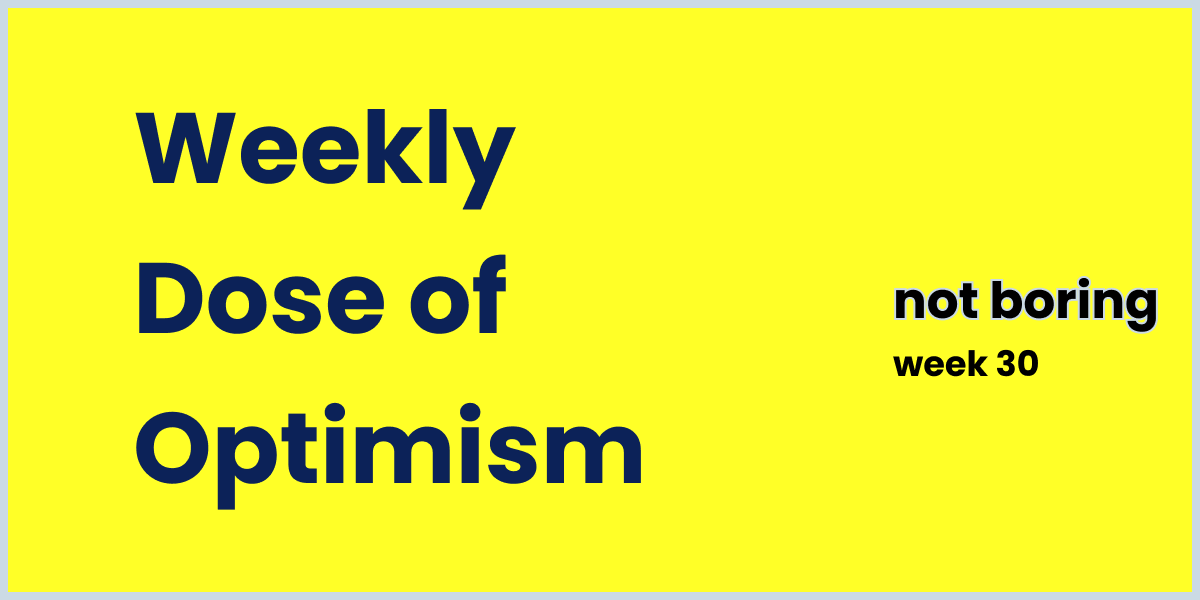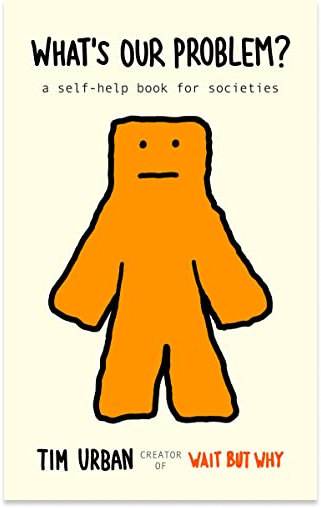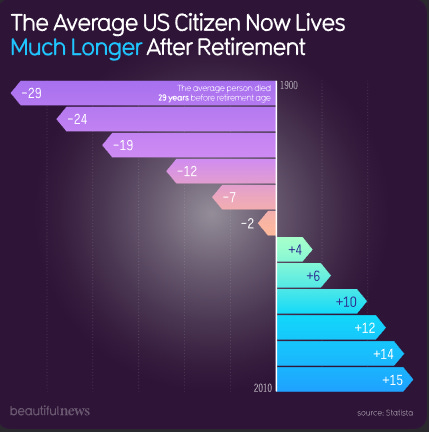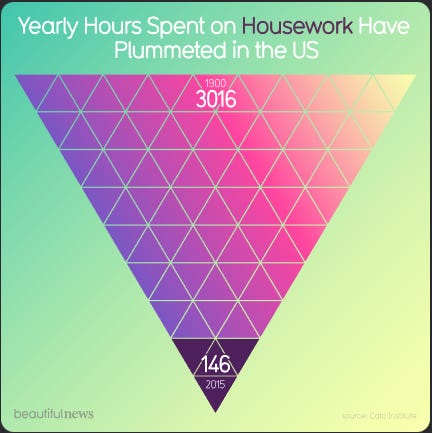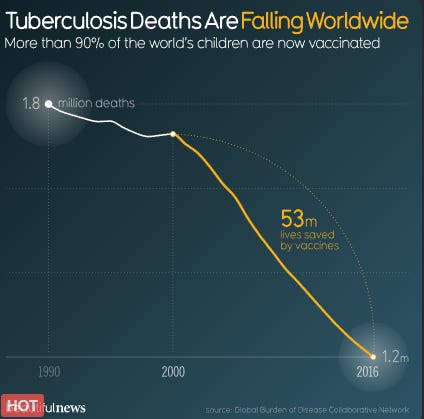

Weekly Dose of Optimism #30
source link: https://www.notboring.co/p/weekly-dose-of-optimism-30
Go to the source link to view the article. You can view the picture content, updated content and better typesetting reading experience. If the link is broken, please click the button below to view the snapshot at that time.

Weekly Dose of Optimism #30
What's Our Problem, T1D, Alzheimer's Detection, Binge Drinking, Beautiful Information
Hi friends 👋,
Happy Friday and welcome back to our 30th Weekly Dose of Optimism. The big 3-0. Thanks for supporting this far. You keep reading and we’ll keep optimisming 🤝.
Let’s get to it.
The Weekly Dose is brought to you by…Sprig
Sprig lets you go beyond analytics and improve your product experience with user insights, delivered fast. The world’s best product teams including the teams at Notion, Loom, and Robinhood use Sprig’s in-app surveys and concept and usability tests to capture insights from their users and build better products.
Sprig means you can do more with less and there’s a plan for every product. Pricing starts at just $175/month and allows you to run two in-product surveys and two concept tests every month.
Every week, at the bottom of the newsletter, I use a Sprig survey to collect insights from you -- you click a button to tell me whether you loved or hated the newsletter and write a comment, and Sprig categorizes responses with machine learning so that I can get a quick pulse check.
Here’s what I love about Sprig:
The UX is clean and simple, consumer-grade, and they have 75 templates which makes getting started so easy
It’s incredibly fast to source participants and launch a survey or concept test
As a dashboard junkie, I love watching the results and AI-driven insights roll in in real-time, even, and especially, when the feedback is harsh!
We actually almost stopped publishing this newsletter after edition #11 until we ran a Sprig Survey and discovered that 95% of you enjoyed reading it…so you can thank Sprig for the Weekly Dose of Optimism!
(1) What's Our Problem?: A Self-Help Book for Societies
A review of Tim Urban’s (Wait But Why) forthcoming book
Packy here. If you’ve been reading Not Boring for a while, you know how much I love Tim Urban’s work. I based my Fount essay on his Neuralink piece. The second sentence in my piece was: “No one alive is better at explaining technology, humans, or Elon than Wait But Why’s Tim Urban.”
So it was a career highlight when Tim sent me a pre-print of his new book, What’s Our Problem? earlier this week. (I’d already pre-ordered it. It comes out Tuesday.)
I’ve been ripping through it over the past couple of days and am about halfway through. It’s even better than I expected.
If human history is a 1,000 page book, each page covering 250 years, we’re turning to page 1,001, which excites and scares Tim because of three facts:
Technology is exponential.
More technology means higher stakes.
My society is currently acting like a poopy-pantsed four-year-old who dropped its ice cream.
We talk a lot about exponential technology in Not Boring and I’m obviously optimistic about all the good things that technology will help people achieve, but there’s a real risk that we fumble the opportunity. One of the saddest facts about the current state of affairs is that, “Everything is amazing and nobody is happy.” It’s gotten worse since Louis CK said that on Conan 13 years ago, and What’s Our Problem? examines why that is, how we got here, and what to do about it.
Our problem, according to the book, is that hypercharged tribalism is winning out over the search for truth. Tim is willing to piss off people on both sides by calling out the “low-rung” thinking that dominates both parties — Trump Republicans and Social Justice Fundamentalists — in order to defend the quest for truth and liberal ideals.
David Deutsch’s Principle of Optimism states that “All evils are caused by insufficient knowledge.” In order to cure those evils, we need to get back to a society that prioritizes truth over tribe. It’s going to be difficult to get out of this rut, but naming the problem and explaining it in a way that anyone can understand is an important first step.
Reading What’s Our Problem? has made me more optimistic that we can get out of this mess if enough people snap out of and push back on the base tribalism that’s taken over. It’s certainly made me rethink my own positions. Unless something goes horribly wrong in the back half of the book, I can safely make this claim:
America will be a better country if everyone reads this book. 🇺🇸
More pre-orders means it will shoot to the top of more lists, which means more people will read it. Do your part. Order it.
(2) How a pioneering diabetes drug offers hope for preventing autoimmune disorders
Elie Dolgin for Nature
Teplizumab is a type of antibody therapy. It blocks T cells, the ’attack dogs’ of the immune system, stopping them destroying insulin-producing islet cells in the pancreas. It’s also the first drug proven to delay the onset of an autoimmune disorder. And its development provides a roadmap for the discovery of pharmaceuticals to stall or prevent other conditions, including rheumatoid arthritis and multiple sclerosis.
The effectiveness of Teplizumab in treating Type 1 Diabetes is significant for two reasons. First, over a year’s long study the treatment was shown to delay the onset of T1D symptoms by an average of five years. For patients like Mikayla (profiled in the Nature piece) it’s delayed her need for insulin therapy for 6.5 years (and counting). Second, Teplizumab is the first drug of its kind to delay the onset of any autoimmune disease, such as rheumatoid arthritis and multiple sclerosis.
Teplizumab is an antibody therapy, that blocks T-Cells from destroying insulin-producing islet cells in the pancreas. There’s been a recent wave of advancement in T-Cell therapies, which prompted this tweet from Not Boring’s own Elliot Hershberg:
(3) Blood test for early Alzheimer’s detection
From the NIH
These results suggest that SOBA could detect toxic oligomers in the blood even before cognitive impairment occurs. It could thus form the basis for early diagnostic tests of Alzheimer’s disease and other neurodegenerative diseases.
This study was published back in December ‘22, but for whatever reason was trending on Hacker News this week, and given its significance we thought we’d re-surface it. A new test, which is not yet widely available, is able to detect the early biological signs of Alzhiemer’s disease. Alzheimer’s disease involves formation of toxic aggregates, called oligomers, which start to form 10-20 years prior to the onset of Alzheimer’s symptoms. The new test, called SOBA, can detect these oligomers early and allows for intervention prior to Alzheimer’s causing irreparable brain damage.
Variants of the SOBA test may also be able to identify oligomers associated with other neurodegenerative diseases, such as Parkinson’s, well before signs of cognitive impairment. Early detection FTW.
(4) Binge Drinking May Be Curbed With a Pill
Ted Alcorn for The New York Times
By the end of the 12-week study, those given naltrexone reported bingeing less frequently and consuming less alcohol than those who had been given a placebo, a change that lasted for up to six months. The most commonly reported side effect of naltrexone was nausea, although it was generally mild and resolved itself as people adjusted to taking the drug.
The pace at which new therapies, treatments, and drugs are being introduced is quite dizzying. But sometimes, advancement is merely a matter of repurposing existing treatments for new use cases. One example here is semagltude, a drug traditionally used to treat diabetes that is now being repurposed as a highly effective weight-loss treatment. Another example is naltrexone.
The drug has been used for decades in treating patients with severe alcohol disorders. Now, a new study finds that it may also be effective (and feasible) for more casual binge-drinkers. “Casual binge-drinker” seems like an oxymoron, but nearly half of American drinkers report “binging” — defined as four drink for males and three drinks for females in one setting. If occasionally drinking four+ drinks during a single sitting is cool, then consider me Miles Davis…or something.
The double-blind study, which tracked 120 men, found that taking naltrexone prior to drinking resulted in less frequent binging and less alcohol consumption. The most common side effect was nausea, but that generally subsided as the participants’ bodies acclimated to the drug.
If you’re one of those “casual binge-drinkers,” it may be worth asking your healthcare provider if naltrexone is right for you. And at the very least, mix in a water.
(5) Beautiful News
From informationisbeautiful.net, h/t @jmwass
The Weekly Dose of Optimism was founded on the core idea that a lot of really positive stuff is happening in the world, but for whatever reason, that information doesn't make its way into the news cycle. Optimism doesn’t usually bleed, so it doesn’t usually lead. So we understand the importance of conveying optimistic stories in a way that’s easily digestible, entertaining, and consumable. We (try to) do that through writing. But a picture is worth a thousand words — which is why we were excited to discover information is beautiful, a website that displays positive news/facts/trends in beautiful infographics. It’s like Our World in Data, but if the charts were designed for Instagram. We highly recommend you spend a moment “Progress Scrolling™” before you head off for the weekend.
Did you enjoy reading this Weekly Dose of Optimism?
(Powered by Sprig)
That’s all for this week. We’ll be back in your inbox on Tuesday.
Thanks for reading,
Recommend
About Joyk
Aggregate valuable and interesting links.
Joyk means Joy of geeK
